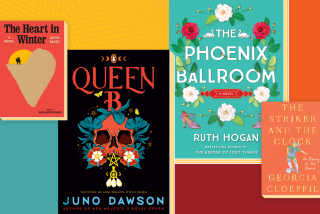One times one
- Share via
“I am almost a hundred years old; waiting for the end, and thinking about the beginning.”
Meg Rosoff’s third novel is not about old age, despite its narrator’s advanced years, and it’s not really about youth, although it recounts that narrator’s first teenage love. It is a book about the fluidity of identity: about the ways we assemble our personalities from fragments we perceive about others; and about our disposition to embody all our ages, all at once -- to have, as Shakespeare puts it in “Measure for Measure,” “nor youth, nor age, / But, as it were, an after-dinner’s sleep, / Dreaming on both.”
These thematic elements, interesting enough on their own, get livelier in the context of Rosoff’s career. She’s a Boston native who has lived in England since 1989, and her debut novel, “How I Live Now,” was the story of a 15-year-old New York girl who goes to stay with cousins in the English countryside, only to be trapped there by a near-future war. Although the London newspapers reviewed Rosoff’s debut as an adult novel, it won the Guardian prize for children’s fiction and sold to children and adults in equal numbers. In America, it was published as a young-adult novel and won the 2005 Michael L. Printz Award, a prestigious young-adult prize.
Rosoff’s second novel, “Just in Case,” starred another 15-year-old -- a depressed boy in suburban Luton, not far from London -- and was published in England as a young-adult book in hardcover, winning the 2007 Carnegie Medal. Its British paperback edition was aimed at adults, who also proved to be a dedicated readership. Her new novel, “What I Was,” has followed a similar publication formula in England, while in the U.S. it’s being marketed to grown-ups, like Mark Haddon’s bestselling “The Curious Incident of the Dog in the Night-Time” (narrator’s age: 15) and David Mitchell’s “Black Swan Green” (narrator’s age: 13).
I’m reporting these publishing strategies not because I pretend to understand them, but because they address the same slippery questions about age and identity as Rosoff’s new novel. At what age, as a reader, does one lose interest in the notion of “coming of age”? Doesn’t this process of self-assessment repeat throughout one’s lifetime after its teenage incarnations, gathering ferocity in middle and even old age? Isn’t the bildungsroman, like every other kind of literature, resistant to classification, flowing across boundaries to absorb young and old readers alike, dreaming on both?
“What I Was” offers a satisfying answer to these questions, beginning, aptly enough for a tale about fluidity, with its watery atmosphere. The place is East Anglia, whose parenthesis of marshy English coastline, through centuries of Roman, Saxon and Viking invasions to the present day, has been sinking into the North Sea. Two miles inland, through a perpetual mist, Rosoff imagines a gloomy school for boys called St. Oswald’s, to which the book’s narrator (we don’t learn his name until the end) has been sent at age 16 after performing poorly at several other boarding schools.
The boy can tolerate the usual indignities of public-school life: the tragic food, the freezing dormitories, the Hobbesian sadism of the students and the droning eccentricities of the teachers, a shuffling band of misfits. What he can’t bear is the regimentation, the smug certainty with which he’s being marched toward an adulthood distinguished only by grim respectability, with a “minor job, minor wife, minor life.”
Even so, he’s most anxious to avoid expulsion, for a most particular reason: He falls in love. During a bout of forced exercise, he’s jogging sorrily along the beach when he comes upon a group of decaying fishermen’s shacks. One of them, it turns out, is inhabited by a boy about his age. Half Crusoe and half wild child, the boy, whose name is Finn, has no evidence of a family and has somehow evaded every bureaucratic regulation set up to ensnare children of the empire. He lives by his wits on the beach and in the sea, expertly piloting a kayak to catch herring and crabs, which he trades for necessities in town.
The independence and solitude of Finn’s life are fiercely intoxicating to the narrator, who flouts school rules to spend time with the boy. Taciturn but physically eloquent, Finn becomes a facsimile for the narrator’s fantasies: Sometimes he’s a reincarnation of St. Oswald, the 7th century warrior king for whom the school is named; or an Anglo-Saxon fisherman from another era, drowned and resurrected by the ceaseless sea; most often for the narrator, in keeping with a teenager’s narcissism, Finn is “a purer, bolder, more compelling version of myself.”
It’s remarkable what a big leap Rosoff has made here. The tact that her earlier novels showed toward their young protagonists was weighed down by an anxious-to-please sensationalism: anorexia, World War III, airport disasters, flying body parts, regrettable sexual impulsiveness. “What I Was” shows us a more confident author whose poetry lies in her elegant, straightforward descriptions of human activity -- cooking crabs, climbing a chalk cliff, learning to sail -- instead of lurid embellishment. The result is a beautifully crafted tale that seems, like its protagonist, both enduringly old and fluently new.
More to Read
Sign up for our Book Club newsletter
Get the latest news, events and more from the Los Angeles Times Book Club, and help us get L.A. reading and talking.
You may occasionally receive promotional content from the Los Angeles Times.






